
Supplies and Techniques for Repairing Bibles and Other Cherished Books
by PJDeneen
Do you want to repair a book that has become a cherished family treasure? Here is a step-by-step guide to book repair techniques and supplies needed to give new life to old books.
Book repair is not quite a lost art. But in the age of Kindle and bargain book prices some might think it's a pointless one. My mother knew that my husband and I do bookbinding occasionally as a hobby and asked me to repair her Bible.
My first reaction upon seeing the state it was in was to just buy her a new one. But anyone who knows a church-goer knows that an old Bible becomes a cherished treasure with notes from sermons past written on the pages.
These book repair techniques I share here aren't just for Bibles. They can be used to salvage books that have become family heirlooms or any book that you think is irreplaceable. They won't make it like brand new but may help slow down the deterioration and allow you to enjoy it for a few more years with careful use.
Supplies Needed
These are the supplies I used for this project.
- Surgical tweezers
- Surgical spatula, also called a micro spatula
- Document archival repair tape
- Bone folder
- Muslin to repair spine, about 1-1/2 inches larger than spine in both width and length
- Piece of felt cut slightly smaller than size of book spine (optional).
- Aleene's Tacky glue but you may want to use a bookbinder's PVA glue if you want archival quality
- Sponge brush for the glue
- Scissors
Notes on the supplies: You may not need the muslin, felt and glue if the book you're repairing is intact. As you can see from the pictures below, the cover had completely come undone from the Bible so that had to be put back together.
There are other professional quality supplies you can use which I list later in this article.
Problems Before Repair
The book was in bad shape. The body of the Bible had completely loosened from the spine. Because of that, there were tears on many of the pages near the edge of the spine. There were also remnants of glue and bits of old paper on the body of the book and inside cover that had to be removed before I glued the pieces together. You can see all of this in the first photo. The second photo shows how the body of the book itself had become divided in two.
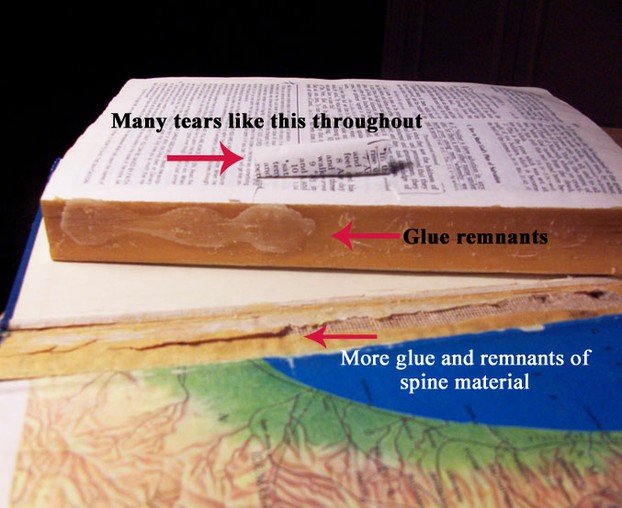 Pre-Repair Problems P.J. Deneen |
Before Repair - Body of Book Divided
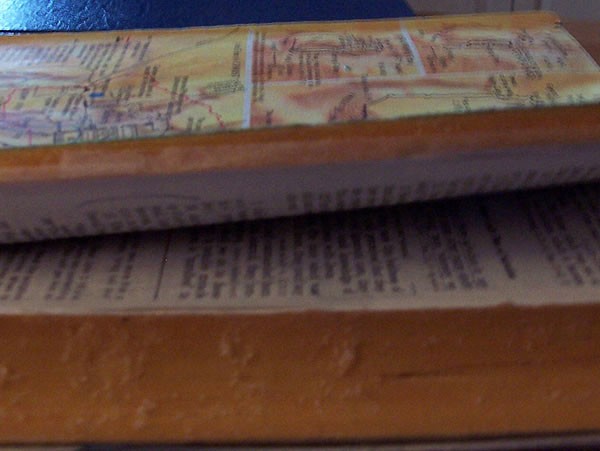 Body of Bible P.J. Deneen |
Before Repair - Inside Cover
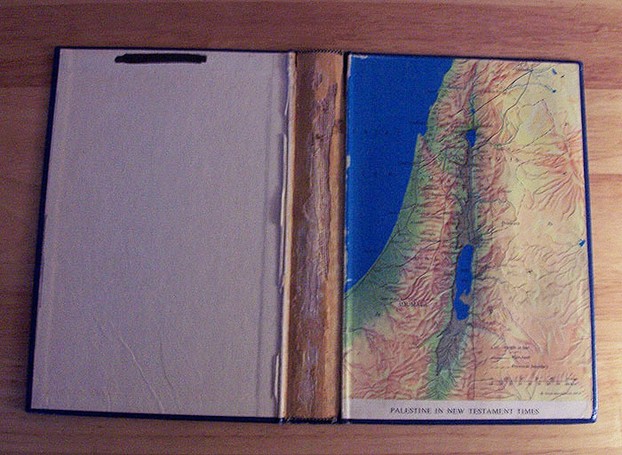 Detached cover before repair P.J. Deneen |
Step One
Trim Paper from Inner Spine
I began first by trimming scraggly edges of paper off of the inside near the spine. As you can see in the photo above, there was paper mainly along the plain white side of the spine. There was a little on the side with the map but I was very careful not to get too carried away in trimming this as my mother wanted me to preserve the map if I could.
Step Two
Remove Glue and Paper from Body of Book and Inner Spine
I very carefully used the tweezers and micro spatula to remove the glue and paper bits from the body of the book and inner spine. I only removed loose paper. I didn't try to remove any glue or paper that was still glued firmly to the spine so as not to risk tearing the book apart any more that it was. This took quite some time. You can't rush this part. Removing as much loose paper and glue remnants as possible will help to leave a smooth finish to place a new layer of glue and material on.
Step Three
Tape Tears
The document archival quality tape is, in my opinion, 100 times better than Scotch tape for book repair. Besides its staying power, it practically blends into the paper. It's very thin so you have to handle it carefully. I used this to tape over all the tears in the book.
Step Four
Glue Book Parts Together and to the Muslin
To make it easier to work with the book from this point on, I placed the two divided pieces together in their proper order and brushed a layer of glue along the spine and let it dry. Then, I glued the muslin to the spine and let this dry. The overhand of fabric makes it easier to handle and stretch. It helps to use the bone folder to smooth the creases out after gluing before it dries.
After the muslin is dry, you can glue the piece of felt to the spine. This isn't necessary but does help if you think you need the extra padding between the spine and the book. Let this dry. Now, trim the excess muslin from the edges.
During Repair - Muslin Glued on Spine
 Muslin Glued on Spine P.J. Deneen |
Step FIve
Glue Body of Book to Cover and Weigh Down
Use the sponge brush to smooth out a layer of glue along the muslin/felt edge of the book and place this on its place on the inner cover. Don't close the book just yet. Place a few books on either side of the book to prop it up in this position with covers flat for about 15 minutes. Or you can just hold it in this position instead. Now close the covers and let this dry for about an hour. Now, weigh down the Bible with other books or another type of weight (bricks, wood) for 24 hours, preferably 48 hours, to be on the safe side as far as making sure the glue is completely dry.
After Repair - Spine Attached to Cover
That's the Bible Standing on it's Cover Edges on a Table
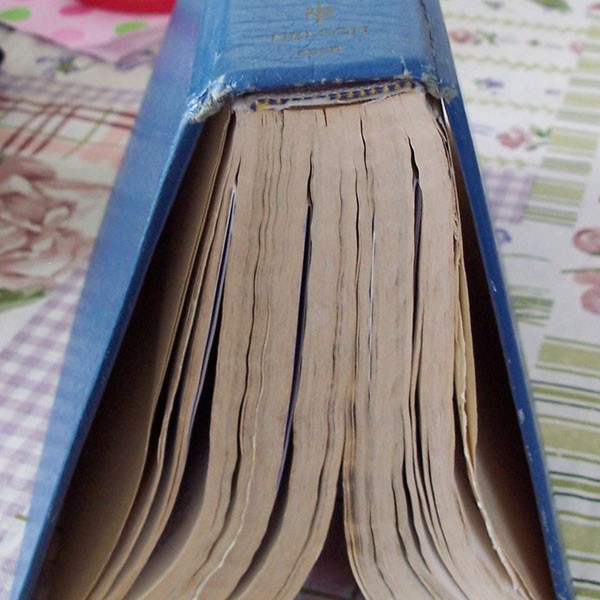 Finished Bible Spine P.J. Deneen |
After Repair - Covers Attached to Book
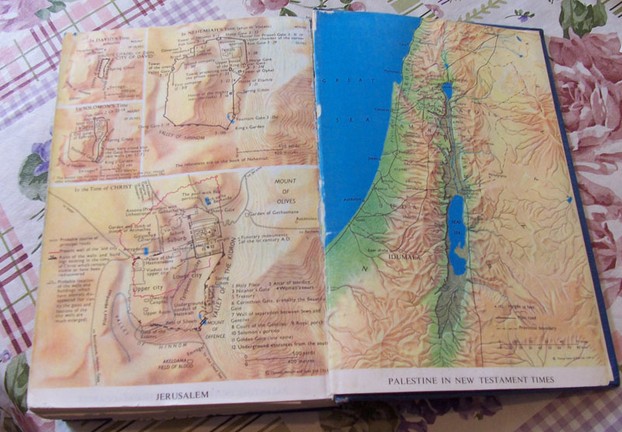 Post Repair Inside Back Cover P.J. Deneen |
Finished Job
Whew! I didn't rip any of the pages.
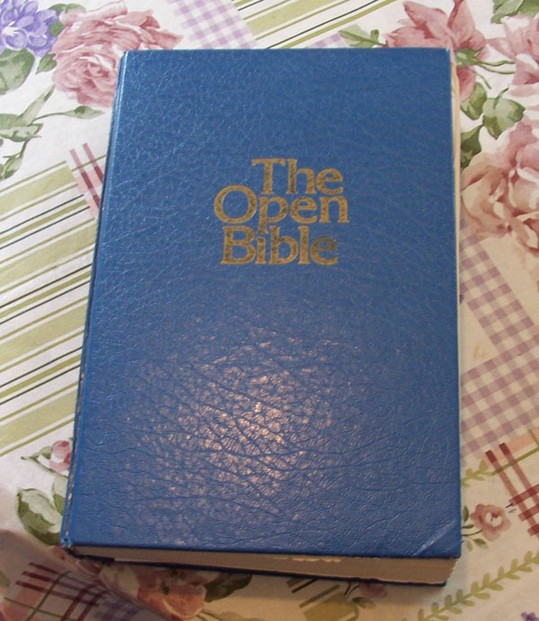 Finished Bible P.J. Deneen |
Step Six - Be Careful!
With the shape this book was in, this was as good of a repair I believe I could have done with some exceptions mentioned below. But I know my mom was just looking to make this Bible readable without losing pages. Mission accomplished. She also has a plastic canvas book cover which will help protect it as well. Be sure that with any repair you do that you treat your subject carefully before, during and after to ensure a longer life.
Things I Wish I Could Have Done Differently
For a bookbinding job from scratch, you wouldn't trim the muslin to the very edges of the spine. You would actually leave an overhang and place a cover paper over it. Since my mom wanted to keep her map, I couldn't do this. I wish now that I would have made a color copy of the map and placed that on top of the muslin. This might give it a little more staying power.
The first few pages of the bible were also extremely wrinkled. I considered ironing these on a low heat but because of how thin bible pages are, I decided against it. From my recent research, there are techniques that might work to help get the wrinkles out, and I might try these.
These were the only things about this repair job that I was unhappy about, but overall, I was proud of the job. And mom was thrilled to have her Bible back without fear of it crumbling to pieces at church. I hope this tutorial has given you some good ideas on repairing that very special book of yours.
 | Book Binding Super Cloth 18x30 Sheet Lineco Bookbinding Super Cloth is a fine open cotton weave that gives good adhesive penetration to unite signatures while leaving the backbone flexible. 18 x 30 inches. View on Amazon |
 | Transparent Mending Tissue 1/2"x600" Lineco Archival Transparency Mending Tissue is an acid-free tissue with adhesive. Slit to a convenient 1/2 inch width for easy unobtrusive repairs to small tears in the paper. 1... View on Amazon |
 | The Craft of Bookbinding Profusely illustrated step-by-step guide enables you to rebind books, paperbacks, periodicals, more. Book sewing of all types (antique, flexible, lockstitch, whipstitch), plus h... View on Amazon |
 | Hand Bookbinding: A Manual of Instruction Expert guide to creating fine books by hand. Thorough, detailed instructions, with over 270 helpful illustrations, cover materials, tools and equipment, making a slipcase, rebin... View on Amazon |
Handmade Bookmark for Bibles
Updated: 12/22/2012, PJDeneen
Thank you! Would you like to post a comment now?
3
Disclosure: This page generates income for authors based on affiliate relationships with our partners, including Amazon, Google and others.
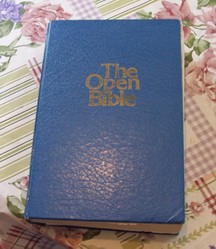





















 How to Create Your Own Monogrammed Filet Crochet Bookmarkon 12/31/2011
How to Create Your Own Monogrammed Filet Crochet Bookmarkon 12/31/2011
 Crochet Towel Topper Free Patternon 11/28/2011
Crochet Towel Topper Free Patternon 11/28/2011
 How to Make Almond Milkon 11/25/2011
How to Make Almond Milkon 11/25/2011
 Will Voice Recognition Put Medical Transcriptionists Out of Work?on 06/21/2011
Will Voice Recognition Put Medical Transcriptionists Out of Work?on 06/21/2011


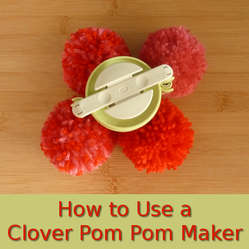
Comments
It sounds like really painstaking work, but well worth it if you are restoring something rare and precious